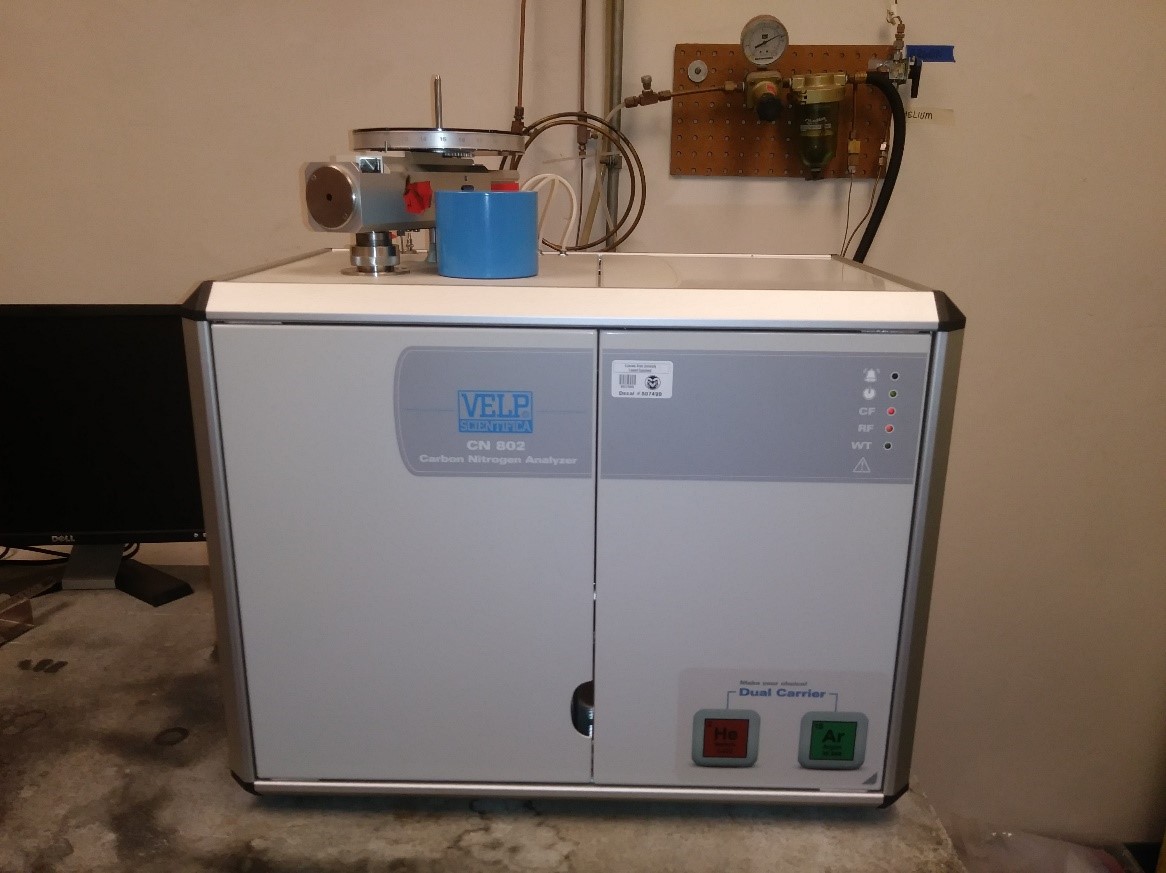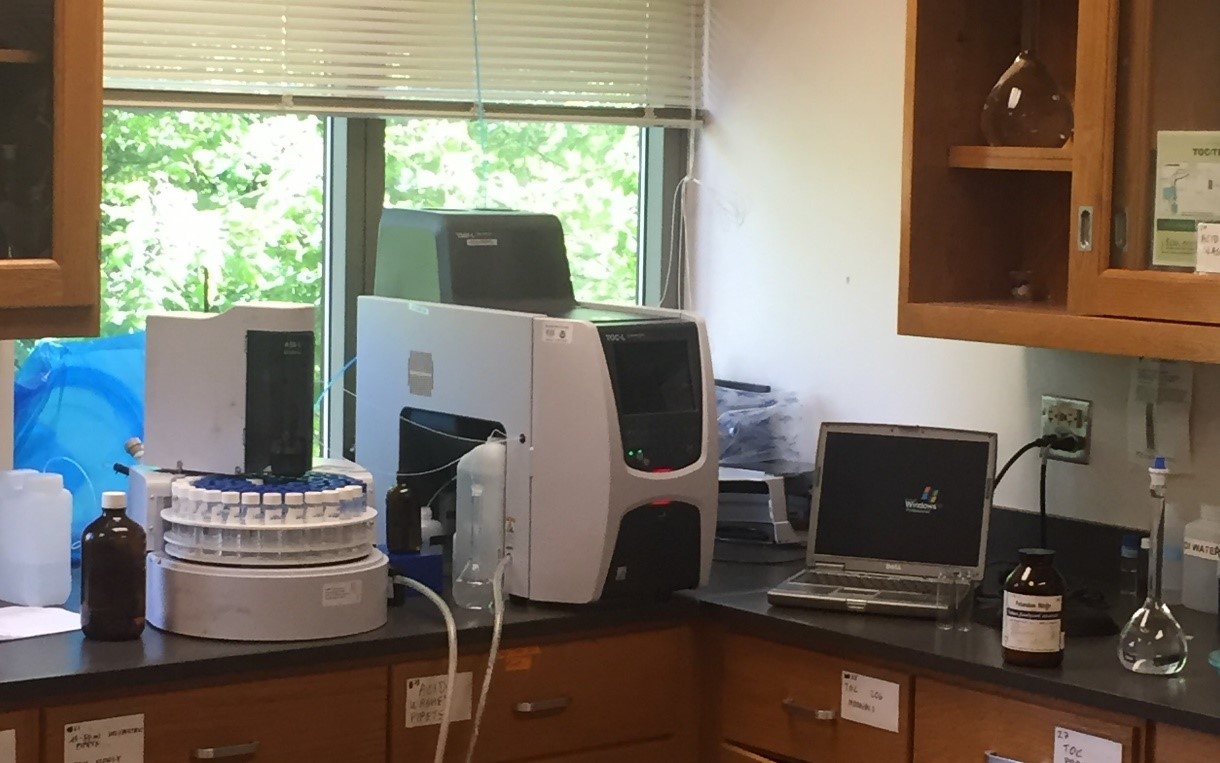Elemental Analysis
EcoCore offers elemental (C and N) analysis on solid samples and aqueous solutions.
Solid samples

Solid samples are analyzed on a Velp CN 802 carbon nitrogen analyzer (Velp Scientifica, Italy). The instrument is primarily used to analyze total C and N concentrations in soil and vegetation samples although it has also been used for fertilizer, animal feeds, animal tissue, plant litter, fecal matter, and a variety of other materials.
The instrument is a dry combustion type with infrared detection for carbon and thermal conductivity detection for nitrogen. It is computer driven with an interfaced balance and a 30 position auto-sampler, which allows up to 3 hours of unattended operation.
Soil and sediment samples should be tested for the presence of inorganic carbon (carbonates) prior to analysis. If samples contain inorganic carbon, the preferred method is to use the instrument to measure the total carbon and measure the inorganic carbon on a separate subsample. See the inorganic carbon section of the routine analysis page or contact EcoCore management for details. The organic carbon is then calculated by difference. Methods involving carbonate removal by acid pretreatment tend to have a negative impact on the nitrogen analysis.
Samples as small as 0.01 g may be analyzed if material is limited. However, plant samples with low nitrogen content may not give good results with small sample sizes. Soils with low carbon and nitrogen concentrations frequently require larger sample sizes (up to 0.5 g) to achieve accurate results.
Samples may be submitted for analysis by EcoCore or clients may be trained to analyze their own.
Aqueous solutions

Carbon and nitrogen are measured in aqueous samples using a Shimadzu TOC-L (Shimadzu Corp. Kyoto, Japan). The instrument is used to analyze C and N concentrations in lake water, stream water ground water, soil extracts (including microbial biomass), and plant extracts.
The combustion type TOC eliminates salt interferences and ensures complete oxidation even with high molecular weight compounds, suspended particles, and refractory compounds. The system incorporates a Non-Dispersive Infrared (NDIR) detector for maximum sensitivity and durability. The measurement range is from 100 ppb to 30,000 ppm.
The Total Nitrogen Module permits carbon and nitrogen analysis simultaneously. The TNM-L utilizes a chemiluminescence detector to measure Total Nitrogen (TN) in the range of 50 ppb to 10,000 ppm.
The instrument has a 68 position autosampler for 40-mL vials.
Salt solutions greater than 0.05 molar are diluted prior to analysis to minimize damage to the instrument.
Clients may be trained to run their own samples or have EcoCore run them.
The instrument can be configured to measure the following forms of carbon and nitrogen. A brief explanation of these forms can be found below:
- Total carbon
- Total dissolved carbon
- Total organic carbon
- Dissolved organic carbon
- Non-purgeable organic carbon
- Total inorganic carbon
- Dissolved inorganic carbon
- Total nitrogen
- Total dissolved nitrogen
- Total Carbon and Nitrogen
- Non-purgeable organic carbon and total nitrogen
- Organic nitrogen can be determined by measuring the total nitrogen on this instrument and the inorganic nitrogen on the Alpkem. See the nutrient analysis page for information on measuring inorganic nitrogen.
|
Nominal sample size |
20 mls |
|
|
Detection limit |
Carbon |
100 ppb |
|
Nitrogen |
50 ppb |
|
|
Observed precision (CV%) |
~ 5% at 5 ppm |
|
|
Analysis time |
Variable |
|
Total Carbon is all of the carbon in the sample including both suspended solids and dissolved carbon. It includes organic and inorganic forms.
Total Nitrogen is all of the nitrogen in the sample including dissolved nitrogen and suspended solids.
Total Dissolved Carbon and Total Dissolved Nitrogen are the same instrument measurements as Total Carbon and Total Nitrogen except the suspended solids are removed by filtration prior to running the samples on the instrument. They include both organic and inorganic forms.
Total Inorganic Carbon is all of the inorganic carbon (carbonates) in the sample. It includes dissolved forms (HCO3-and CO32-) and any inorganic carbon contained in suspended solids.
Dissolved Inorganic Carbon is all of the inorganic carbon (HCO3-and CO32-) dissolved in the sample. It is the same instrument measurement as Total Inorganic Carbon except the suspended solids are removed by filtration prior to running the samples on the instrument.
Total Organic Carbon is the Total Carbon minus the Total Inorganic Carbon. This requires running the samples twice so most clients opt to run Non-Purgeable Organic Carbon instead (see below).
Dissolved Organic Carbon is the Total Dissolved Carbon minus the Dissolved Inorganic Carbon. This requires running the samples twice so most clients opt to run Non-Purgeable Organic Carbon instead (see below).
Non-Purgeable Organic Carbon is measured by adding a small amount of acid to the sample, bubbling air through the sample to remove the carbonates, then measuring the remaining organic carbon. This is often used to measure Total Organic Carbon or Dissolved Organic Carbon as it can be done in a single instrument run. It should be noted that volatile organic compounds could be lost during the purging process and thus not measured. Since most natural waters do not contain significant amount of volatile organic carbon, this method is considered suitable.